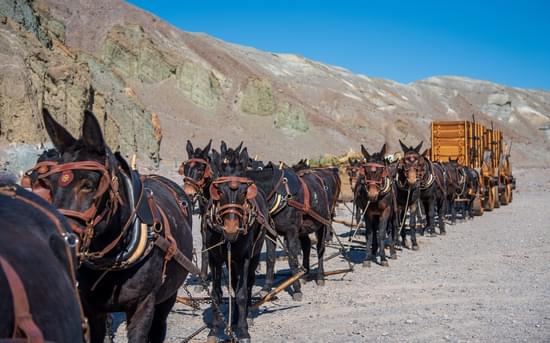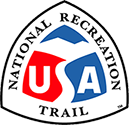




For many people, nothing symbolizes Death Valley more than the famous Twenty Mule Teams.


Designated in 1975
• View more details for this trail
in the NRT Database
• Learn about the NRT Program.
These big teams pulled massive wagons hauling borax from the Harmony Borax Works near Furnace Creek to the railhead near Mojave, a grueling 165-mile, ten-day trip across primitive roads.
The 20-mule teams were teams of 18 mules and two horses that were attached to large wagons that transported borax out of Death Valley, California from 1883 to 1889. The teams traveled from mines across the Mojave Desert to the nearest railroad spur which was located 165 miles away in Mojave CA. The routes were from the Harmony and Amargosa Borax Works to Daggett California and later Mojave; after the Harmony and Amargosa mines shut down in 1888, the mule teams route was moved to the mines at Borate which is located 3 miles east of Calico then back to Daggett; there, they worked from 1891 to 1898 until they were replaced by the Borate and Dagget Railroad. The wagons were the largest ever pulled by draft animals and were designed to carry 10 short tons of borax at a time.
Vestiges of borax mining and the mules who made it possible remain in Death Valley. The adobe ruins of the Harmony Borax Works, which are on the National Register of Historic Places, lie a mile north of The Oasis at Death Valley on Highway 190. A short interpretive trail tells the story of the men who labored here. One of the last remaining wagons is also on display. The Borax Museum, the oldest structure in Death Valley, contains a mineral collection, an exhibit on the history of borax in Death Valley, and pioneer-era mining and transportation equipment.
Twenty Mule Team Canyon, off Highway 190 east of The Oasis at Death Valley, pays homage to those hard-working beasts of burden in a 2.7-mile-loop drive dotted with borax mine shafts. If you watched Star Wars Episode VI: Return of the Jedi the landscape may look familiar. Some of the scenes were filmed in the national park when that type of filming was allowed. The vast majority of the filming that was done at that time is not permitted today to protect park wilderness.
Today the Twenty Mule Teams are only a fond memory, but you may see two of the last remaining wagons here in Death Valley. One is in front of the Furnace Creek Ranch and the other is at Harmony Borax Works. Although the teams only ran for six years (1883 to 1889), they made an enduring impression of the Old West. This is primarily due to a successful advertising campaign promoting 20-Mule-Team Borax Soap and the long-running Death Valley Days radio and television program.